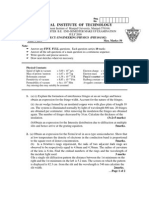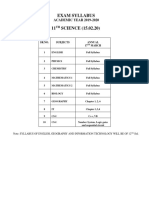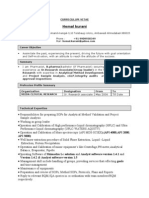0 ratings0% found this document useful (0 votes)
5 viewsMST 2022 Even
MST 2022 Even
Uploaded by
abansal10be22The document is a mid-semester examination for an applied physics course. It contains 7 questions testing concepts related to oscillatory motion, acoustics, ultrasonics, and magnetostriction oscillators. Students are instructed to attempt any 5 of the 7 questions.
Copyright:
© All Rights Reserved
Available Formats
Download as PDF, TXT or read online from Scribd
MST 2022 Even
MST 2022 Even
Uploaded by
abansal10be220 ratings0% found this document useful (0 votes)
5 views1 pageThe document is a mid-semester examination for an applied physics course. It contains 7 questions testing concepts related to oscillatory motion, acoustics, ultrasonics, and magnetostriction oscillators. Students are instructed to attempt any 5 of the 7 questions.
Original Title
MST 2022 EVEN
Copyright
© © All Rights Reserved
Available Formats
PDF, TXT or read online from Scribd
Share this document
Did you find this document useful?
Is this content inappropriate?
The document is a mid-semester examination for an applied physics course. It contains 7 questions testing concepts related to oscillatory motion, acoustics, ultrasonics, and magnetostriction oscillators. Students are instructed to attempt any 5 of the 7 questions.
Copyright:
© All Rights Reserved
Available Formats
Download as PDF, TXT or read online from Scribd
Download as pdf or txt
0 ratings0% found this document useful (0 votes)
5 views1 pageMST 2022 Even
MST 2022 Even
Uploaded by
abansal10be22The document is a mid-semester examination for an applied physics course. It contains 7 questions testing concepts related to oscillatory motion, acoustics, ultrasonics, and magnetostriction oscillators. Students are instructed to attempt any 5 of the 7 questions.
Copyright:
© All Rights Reserved
Available Formats
Download as PDF, TXT or read online from Scribd
Download as pdf or txt
You are on page 1of 1
Roll No
Thapar Institute of Engineering & Technology
SCHOOL OF PHYSICS AND MATERIALS SCIENCE
Mid-Semester Examination, March/April 2022
Course Code: UPH004 Course Name: Applied Physics
Time: 2 Hours; MM: 35 Course Coordinator: Dr. Dwijendra Pratap Singh
Instructors: Dr. D P Singh, Dr. D K Singh, Dr. P Uniyal, Dr. Raj Kumar, Dr. S Marik, Dr. S K Mahatha, Dr. S Kashyap
Note: Attempt any five questions out of seven. Assume missing data if any, suitably. All the symbols have their
usual meaning.
Q1 a) Write down the general solution of the differential equation describing the motion of
an undamped spring-mass oscillator. Use the solution to show that the total energy of the
oscillator is independent of time. Plot the kinetic and potential energies as a function of (1+3+1)+2
position.
b) Consider two identical spring-mass oscillators. Is the statement "if the masses of the
two oscillators are pulled aside by the distances of 2A and 3A, respectively, the frequency
of oscillation will be different upon their release" true? Justify your answer.
Q2 a) Consider a damped spring-mass oscillator of mass m and spring constant k. It is given (3+1+1)+2
that the power loss of the oscillator due to damping is proportional to the square of speed
with the constant of proportionality being b. Derive the differential equation to describe
the motion of the oscillator. Write the conditions and plot the displacements from the
equilibrium point as a function of time for the underdamped, critically damped, and
overdamped cases.
b) It is observed that the relaxation time for a damped spring-mass oscillator is 0.5 s when
the mass is 1.8 kg. Find the frequency of oscillation if the spring constant is 32 N/m.
Q3 a) Derive the differential equation for a damped electrical oscillator. 2+2+3
b) What is logarithmic decrement? Derive the expression.
c) Following specifications are given for an LCR circuit. L = 0.1 mH, C = 10 pf,
R = 0.2 D. Whether the motion of the charge is oscillatory or not? If it is oscillatory,
determine the frequency of oscillation.
Q4 a) Explain the limitation of Sabine's formula for reverberation time. How can the 4+3
limitation be overcome?
b) A curtain of dimensions 5 ft x 5 ft is hung at the center of the reverberation chamber
whose dimensions are 10 ft x 10 ft x 20 ft. If the reverberation time is 1 s and 1.5 s
respectively, for two different sources of the sound of 40 W and 80 W respectively then
calculate the average absorption coefficient of the room with the curtain. The velocity of
sound is 1126 fl/s.
Q5 a) Write down the conditions for an acoustically good hall. Suggest a method to estimate 5+2
the absorption coefficient of a material.
b) Is the statement true or false "A room covered with the soft porous surface will have a
relatively larger reverberation time"? Justify your answer.
Q6 a) What is the principle of a magnetostriction oscillator? Explain its working with a 5+2
suitable diagram.
b) Describe the application of ultrasonic waves in SONAR.
Q7 a) Describe any four methods by which an ultrasonic wave can be detected? 4+3
b) An ultrasonic generator has a quartz crystal vibrating at its fundamental frequency. The
thickness of the crystal is 2 mm, the density is 2650 kg rrl-3, and Young's modulus is
7.9 x 1010 Nm-2. Calculate the fundamental frequency of vibration. If the inductance value
of the tank circuit of the generator is 5 mH, find the value of the capacitance under
resonance.
You might also like
- GRP3.10001 Selection of Hazard Evaluation and Risk Assessment TechniquesDocument73 pagesGRP3.10001 Selection of Hazard Evaluation and Risk Assessment TechniquesHernán Daza0% (1)
- 11th Physics Model Question Paper em PDFDocument3 pages11th Physics Model Question Paper em PDFAjitNo ratings yet
- A Literature Review of Use of Recycled Concrete Aggregates PDFDocument61 pagesA Literature Review of Use of Recycled Concrete Aggregates PDFyyanan111875% (4)
- Mysterious Gun Death-A Case ReportDocument4 pagesMysterious Gun Death-A Case ReportFadel WidePutraNo ratings yet
- UPH004Document2 pagesUPH004tjainbe23No ratings yet
- Applied Physics Question CollectionDocument10 pagesApplied Physics Question CollectionBishal sah TeliNo ratings yet
- S6 Examen Physik Semester 2 2021 - 22 EN v.1 1Document5 pagesS6 Examen Physik Semester 2 2021 - 22 EN v.1 1danielemana17No ratings yet
- 107 B.tech Engg - PhysicsDocument5 pages107 B.tech Engg - Physicsrhq4w5hgm7No ratings yet
- School of Physics & Materials Science: Thapar University, PatialaDocument1 pageSchool of Physics & Materials Science: Thapar University, PatialaPRADYUMAN PRATAP CHAUDHARYNo ratings yet
- Phy 1071 - Phy-1071 - Engineering Physics-2Document2 pagesPhy 1071 - Phy-1071 - Engineering Physics-2Challa SaiNo ratings yet
- GKV University Physics Questions PaperDocument8 pagesGKV University Physics Questions PaperKrishnaNo ratings yet
- Bas 001Document6 pagesBas 001Sakkeer A VNo ratings yet
- Question Bank BAS-101Document5 pagesQuestion Bank BAS-101s9650862No ratings yet
- Problem Set 1Document2 pagesProblem Set 1Farhan AnwerNo ratings yet
- Radprod Exam PapersDocument90 pagesRadprod Exam PapersannaptaNo ratings yet
- @sachin - Sir - Physics: Version 2.ODocument9 pages@sachin - Sir - Physics: Version 2.OPrakharNo ratings yet
- UD11T3102-Applied Sciences-MDocument2 pagesUD11T3102-Applied Sciences-MHARINDAR PALNo ratings yet
- Bd91etutorial Sheet FinalDocument11 pagesBd91etutorial Sheet FinalNishant JainNo ratings yet
- PHY1014Document3 pagesPHY1014Sri HarshaNo ratings yet
- Image MarkedDocument1 pageImage MarkedVarunNo ratings yet
- Modern PhysicsDocument9 pagesModern PhysicsmananbalujaNo ratings yet
- Manipal Institute of Technology: Subject: Engineering Physics (Phy101/102) Time: 3 Hrs. Max. Marks: 50Document6 pagesManipal Institute of Technology: Subject: Engineering Physics (Phy101/102) Time: 3 Hrs. Max. Marks: 50Chhayank AnkurNo ratings yet
- PhysicsDocument4 pagesPhysicsahsanjaved172099No ratings yet
- Chem 151 - PS 1Document2 pagesChem 151 - PS 1Alelie AyenNo ratings yet
- New Microsoft Word DocumentDocument11 pagesNew Microsoft Word DocumentMuhammad WaqasNo ratings yet
- QP CODE: 23104206: Reg No: NameDocument2 pagesQP CODE: 23104206: Reg No: NameAthul LXNo ratings yet
- PH 5218 Quantum Mechanics, Atomic and Molecular Physics - UG - 1st Sem-Dec-2022Document2 pagesPH 5218 Quantum Mechanics, Atomic and Molecular Physics - UG - 1st Sem-Dec-2022Soumyadeep DasNo ratings yet
- CBSE Sample Paper Class 12 Physics Set 3: All Questions Are Compulsory. There Are 27 Questions in AllDocument4 pagesCBSE Sample Paper Class 12 Physics Set 3: All Questions Are Compulsory. There Are 27 Questions in AllI dont have a NameNo ratings yet
- Model Test Paper 2Document3 pagesModel Test Paper 2Aman bansalNo ratings yet
- Tut SheetDocument9 pagesTut SheetramparkNo ratings yet
- Phys 114-Internal 2004Document1 pagePhys 114-Internal 2004api-3763291No ratings yet
- Aph 301 Quantum Mechanics IDocument4 pagesAph 301 Quantum Mechanics Ibrianrutto09No ratings yet
- UNIT 1 Quantum MechanicsDocument4 pagesUNIT 1 Quantum Mechanicsjhonbravo06071965No ratings yet
- QuantumMechanics QuetionsDocument2 pagesQuantumMechanics QuetionsvijayNo ratings yet
- Engineering Physics (PHY 1051) (Regular)Document2 pagesEngineering Physics (PHY 1051) (Regular)aryansorout1612No ratings yet
- QP GeolM 23 GEO PHYSICS PAPER III 250623Document8 pagesQP GeolM 23 GEO PHYSICS PAPER III 250623Arvind sharmaNo ratings yet
- Physics Qns Bank Second Sem. B.tech.Document11 pagesPhysics Qns Bank Second Sem. B.tech.karanchiranjibeeNo ratings yet
- Candidates Are Required To Give Their Answers in Their Own Words As Far As Practicable. The Figures in The Margin Indicate Full MarksDocument3 pagesCandidates Are Required To Give Their Answers in Their Own Words As Far As Practicable. The Figures in The Margin Indicate Full MarksRajeshGuptaNo ratings yet
- UPH004Document1 pageUPH004abansal10be22No ratings yet
- Engineering Physics (PHY 1051)Document2 pagesEngineering Physics (PHY 1051)aryansorout1612No ratings yet
- 2016 PH 1201Document2 pages2016 PH 1201rupampaik2303No ratings yet
- Tutorial Sheets - Physics - Unit 1, 2 & 3Document8 pagesTutorial Sheets - Physics - Unit 1, 2 & 3Kadis PrasadNo ratings yet
- Physics Question Set - 082544Document8 pagesPhysics Question Set - 082544Abu Syeed Md. Aurangzeb Al MasumNo ratings yet
- Sem5 PHSH Dse2Document4 pagesSem5 PHSH Dse2questionwbcsNo ratings yet
- Physics (Important Questions)Document4 pagesPhysics (Important Questions)Ashish MishraNo ratings yet
- Final Assessment Test - November 2016: Course: Class NBR(S) : Slot: Time: Three Hours Max. Marks: 100Document2 pagesFinal Assessment Test - November 2016: Course: Class NBR(S) : Slot: Time: Three Hours Max. Marks: 100VarunNo ratings yet
- 3.tutorials PhyDocument2 pages3.tutorials Physaisasank31No ratings yet
- Tom Mboya University College: SCH 202: Inorganic Chemistry I DATE: 16/12/2019 Time: 3 HoursDocument4 pagesTom Mboya University College: SCH 202: Inorganic Chemistry I DATE: 16/12/2019 Time: 3 HoursEZEKIEL IGOGONo ratings yet
- SEMESTER-X - Physics Questions - 2020 - AU PDFDocument7 pagesSEMESTER-X - Physics Questions - 2020 - AU PDFRaunak AnjumNo ratings yet
- ALL QB's PDFDocument36 pagesALL QB's PDFanimesh0gargNo ratings yet
- Physics Backlog ExamDocument2 pagesPhysics Backlog ExamDattatray SangaleNo ratings yet
- (2nd Sem) - Engineering-Physics-2-Eas-201-2011-12Document3 pages(2nd Sem) - Engineering-Physics-2-Eas-201-2011-12Mahima FamousNo ratings yet
- 11th Physics Model Question Paper emDocument3 pages11th Physics Model Question Paper emAjit0% (1)
- FIRST/SECOND Semester BE Degree Examination: Engineering Physics - 21phy12/22Document3 pagesFIRST/SECOND Semester BE Degree Examination: Engineering Physics - 21phy12/22Dinesh Naik GNo ratings yet
- Amlp 2015Document6 pagesAmlp 2015bikramorigaonNo ratings yet
- Physics Numerical AssignmentDocument2 pagesPhysics Numerical Assignmentinterestingfacts2525No ratings yet
- Phy 1071 - Phy-1071 - Engineering PhysicsDocument2 pagesPhy 1071 - Phy-1071 - Engineering PhysicsHarshita GauravNo ratings yet
- First Year Undergraduate Inorganic Chemistry WorkbookDocument59 pagesFirst Year Undergraduate Inorganic Chemistry WorkbookSkills for Scientists100% (1)
- General Instructions:: Sample Question Paper - 23 Physics (042) Class-XII, Session: 2021-22Document6 pagesGeneral Instructions:: Sample Question Paper - 23 Physics (042) Class-XII, Session: 2021-22abcdNo ratings yet
- Product Data Sheet G Series Pneumatic Dimensions Data Imperial Bettis en 84262Document32 pagesProduct Data Sheet G Series Pneumatic Dimensions Data Imperial Bettis en 84262Juan Pablo LoperaNo ratings yet
- DLL Oceanic OceanicDocument2 pagesDLL Oceanic OceanicHelen Grace Llemos Cabalag50% (2)
- ch05 Lecture 8eDocument78 pagesch05 Lecture 8eJeanessa MaralangNo ratings yet
- Food Safety Knowledge and Practices Among Fresh Coconut VendorsDocument6 pagesFood Safety Knowledge and Practices Among Fresh Coconut VendorsSamantha Jesica SalesNo ratings yet
- The Evolution of Bizarre Structures' in Dinosaurs: Biomechanics, Sexual Selection, Social Selection or Species Recognition?Document15 pagesThe Evolution of Bizarre Structures' in Dinosaurs: Biomechanics, Sexual Selection, Social Selection or Species Recognition?Manuel PérezNo ratings yet
- Bo de Thi Tieng Anh Lop 10 Hoc Ki 1 Khong Co Dap An 14 deDocument49 pagesBo de Thi Tieng Anh Lop 10 Hoc Ki 1 Khong Co Dap An 14 dethha020708No ratings yet
- Ucsp q2 Module 5 Week 13Document26 pagesUcsp q2 Module 5 Week 13hannierakistaNo ratings yet
- Dy DX Y+ X+: Question Details Zilldiffeq9M 2.2.010. (3916561)Document1 pageDy DX Y+ X+: Question Details Zilldiffeq9M 2.2.010. (3916561)omarNo ratings yet
- Image ProductionDocument61 pagesImage ProductionModestus Ogbuka100% (3)
- The Nature and Characteristics of PersonalityDocument43 pagesThe Nature and Characteristics of PersonalitymajerinmaylosaritaNo ratings yet
- (Mathematical Olympiad Series) Mathematical Olympiad in China (2009-2010) Volume 9 (Problems and Solutions) - FRONT MATTER (2013)Document26 pages(Mathematical Olympiad Series) Mathematical Olympiad in China (2009-2010) Volume 9 (Problems and Solutions) - FRONT MATTER (2013)Kevin Mesić100% (1)
- ICL Fyrolflex SOLDP MSDSDocument8 pagesICL Fyrolflex SOLDP MSDSprabhat singhNo ratings yet
- 1.2-Binomial Past PapersDocument5 pages1.2-Binomial Past PapersAnkush ChawlaNo ratings yet
- Geberit Gulf Siphonic Rainwater Systems Techtalk February 2021Document41 pagesGeberit Gulf Siphonic Rainwater Systems Techtalk February 2021Kim Duy DoanNo ratings yet
- 6503822143-000500 CD DocsDocument63 pages6503822143-000500 CD DocsCristopher ReyesNo ratings yet
- Detalles para La InstalaciónDocument4 pagesDetalles para La InstalaciónSebastián ArandaNo ratings yet
- Personal Development Midterm ExamDocument4 pagesPersonal Development Midterm ExamElsie Arcenas EtesNo ratings yet
- Prince Edward County: AppellationDocument3 pagesPrince Edward County: AppellationShiva GaurangNo ratings yet
- Hemal CVDocument2 pagesHemal CVHemal KuraniNo ratings yet
- Lesson 4.1 - Rectangular Coordinate SystemDocument67 pagesLesson 4.1 - Rectangular Coordinate SystemAlthea Ruth AlesnaNo ratings yet
- Summary of Grades JHSDocument76 pagesSummary of Grades JHSDonabel CariosNo ratings yet
- 8p+2q+7r - SolutionDocument1 page8p+2q+7r - SolutionFelix TzoyNo ratings yet
- Sirona Orthophos SL Dental X-Ray - Service ManualDocument472 pagesSirona Orthophos SL Dental X-Ray - Service Manualjolupeco44No ratings yet
- BIG II Sundaland PDFDocument231 pagesBIG II Sundaland PDFSatyaThoenktherKodokngorek100% (2)
- Reduced PRF18-IP GCAP General Santos City - WEB - 28novDocument204 pagesReduced PRF18-IP GCAP General Santos City - WEB - 28novKim Yun Shik PegoriaNo ratings yet
- Bee Lab Manual Printing PDFDocument59 pagesBee Lab Manual Printing PDFVispendra SinghNo ratings yet
- PCP Flexon CatDocument9 pagesPCP Flexon CatTimur RegarNo ratings yet

























































































